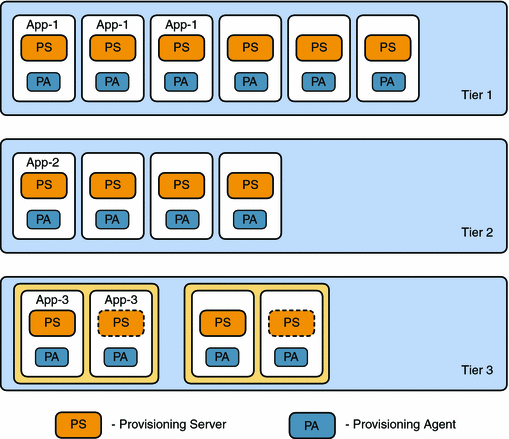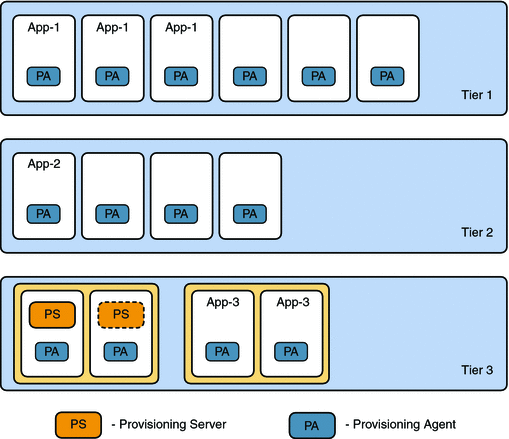Chapter 1 Supported Solution Topologies
You can deploy single-tier and multi-tier solutions using a centralized provisioning server of Sun OTP.
You can set up the provisioning server in the following ways:
-
If you have a separate physical system for the provisioning server, set up the provisioning server on that system. This provisioning server is referred to as external provisioning server.
-
If you do not have a separate physical system for the provisioning server, set up the provisioning server in the stand-alone host or in the first host of the cluster. This provisioning server is referred to as self-contained provisioning server.
External provisioning server is deployed on top of a separate Sun OTP instance. Self-contained provisioning server is deployed along with NEP applications on top of the Sun OTP instance and within the same operating system.
Solution Topologies
The following solution topologies are supported:
One Provisioning Server for Each Sun OTP Instance
In this topology, one provisioning server is present for each Sun OTP instance.
In tier 3, the provisioning server within the normal box indicates the active node whereas the provisioning server within the dotted line box indicates the failover node or additional node. The figure also shows where you can place your applications in each tier.
Figure 1–1 One Provisioning Server for Each Sun OTP Instance

One Provisioning Server for Each Tier
In this topology, one provisioning server is present for each tier.
In tier 3, the provisioning server within the normal box indicates the active node whereas the provisioning server within the dotted line box indicates the failover node or additional node. The figure also shows where you can place your applications in each tier.
In tier 3, the provisioning server is disabled in the second clustered OTP instance.
Figure 1–2 One Provisioning Server for Each Tier

One Provisioning Server for Each Solution Instance
In this topology, one provisioning server is present for the entire solution instance.
In tier 3, the provisioning server within the normal box indicates the active node whereas the provisioning server within the dotted line box indicates the failover node or additional node. The figure also shows where you can place your applications in each tier.
In tier 3, the provisioning server is disabled in the second clustered OTP instance.
Figure 1–3 One Provisioning Server for Each Solution Instance

- © 2010, Oracle Corporation and/or its affiliates
